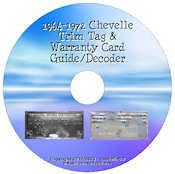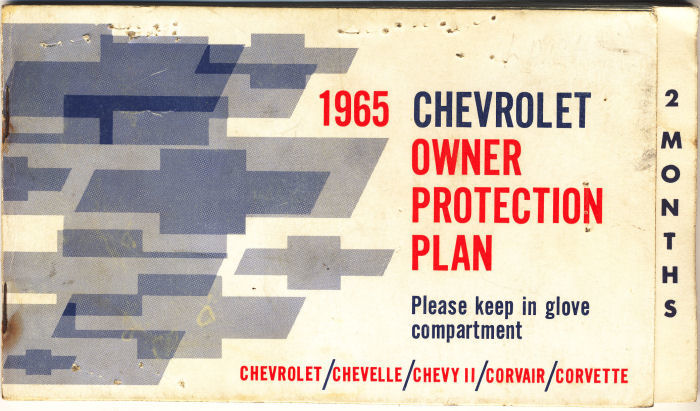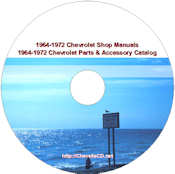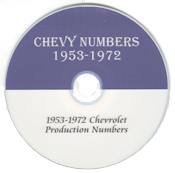1965 Chevelle Warranty Card Protect-O-Plate
|
|
|
|
|
|
|
|
|

Decode your Protect-O-Plate Warranty card.

The Protect-O-Plate (P-O-P) was designed to be used by Chevrolet dealers to identify the owner and the vehicle. The owner's name, address and the vehicle's delivery date was embossed on a special tape affixed to the plate.
The P-O-P was glued to the inside rear cover of the "Chevrolet 1965 Owner Protection Plan and New Vehicle Warranty" booklet. When warranty service was performed on a customer's car the P-O-P was stamped on the work order.
The P-O-P was never meant to be used as documentation the way enthusiasts today use the card. Then again, the body broadcast sheets, trim build sheets, etc. weren't meant to be used either and were more often than not discarded at the assembly plant. Likewise, the P-O-P was usually discarded when the vehicle went out of warranty or when the car was sold as warranties usually did not go to the new owner.
Today, the P-O-P is one of the best pieces of documentation you can have as it not only identifies the VIN but also the correct engine ID code and date of the engine, the correct transmission number and date along with the rear end gear ratio and date. Some options were also coded on the P-O-P such as power steering, power brakes, radio, air conditioning, etc.

The Protect-O-Plate is located inside the inside rear cover of
the warranty booklet. The original stamping is a mirrored stamping,
this example from the Fremont, CA. assembly plant.
Beware of reproduction (fake) Protect-O-Plates, they can make a put-together Chevelle appear to be authentic. Sellers will even put your name on authentic-looking GM tape. Apparently it's not illegal but any fake documentation is misleading to a potential buyer and, to many Chevelle owners, unethical as well.
The example below is from the Kansas City, MO. assembly plant. Note how it differs from the Fremont, CA. assembly plant above. The Fremont plant uses actual RPO codes such as J60 for power brakes and N40 for power steering.

This sample is from the Leeds assembly plant in Kansas City, Missouri.
Line 1:
*
The letter 'B' in this example is the interior trim code for Blue.
* EE in this example is the exterior paint code for Danube Blue.
* If there is a number in the '3' position it could be 1 for power
steering only , 2 for power brakes only, or 3 for both power steering
and power brakes.
*
If there is a number in the "2" position it could be 1 for
a 42 amp alternator, 2 for a 55 amp alternator, or 3 for a 62 amp alternator.
*
The complete VIN code for the car.
If there is a number in the "1" position it could be 1 for Comfort & Convenience Group with standard mirror, 2 for Comfort & Convenience Group with remote control mirror, or 3 for two-speed wipers and washer.
Line 2:
*
The first "1" will contain a number (if ordered) for Air Conditioning;
'1' for Four Season Air Conditioning, '2' for Air Conditioning Equipment
(aftermarket type), or '5' for Four Season Air Conditioning and Rear
Window Defroster. No number indicates this option group was not chosen.
*
The second "1" will contain a number (if ordered) for Power
equipment: '1' for Power windows, '2' for Power tail gate window, '3'
for power windows and power tail gate window, '4' for power convertible
top, or '5' for power windows and power convertible top. No number
indicates this option group was not chosen.
*
The third '1' will contain a number (of ordered) for seat option: '1'
for four-way power front seat, '2' for divided second seat, or '3' for
both. No number indicates this option group was not chosen.
*
Engine identification showing the engine plant code (F in this
example
for the Flint engine plant), a 4-digit number for the day and month
of the engine assembly, and a two-letter suffix code identifying the
engine size/hp and transmission type. in this example the engine was assembled
at the Flint engine plant on February 5 and it's an RPO L79 engine with
manual transmission.
*
The 'H' is for the carburetor type and in this example it is a Holley c4-barrel
carburetor.
Others might be "B" for Bay City, "C" for Carter,
or "R" for Rochester.
*
The P0206 decodes to a Muncie manual transmission (P) with a build date
of February 6. Others might be "S" for Saginaw manual transmission,
and either "C" or "T" for a Powerglide™ built
at Cleveland OH. or Toledo, OH.
*
The bowtie emblem indicates this is a Chevrolet plate.
Line 3:
*
The rear end ratio, date, and rear end assembly plant. in this
example
'CN' is a 3.31:1 gear ratio w/metallic brakes, 0205 is the assembly
date of February 5, and 'B' is for the Buffalo, NY axle plant.
* The "Y" is for the build month of February.
Say you saw it here on © ChevelleWorld




Want more in-depth information on 1964-1972 Chevelles? My Facts and SS Guide
program CD, my Shop Manuals & Parts Catalog program DVD, and my 1964-1972
Trim Tag, Warranty Card program CD and my Chevy Numbers program
CD. Check them and other informative
program CDs at my https://chevellecd.net
website.

 1964 Chevelle
1964 Chevelle 1965 Chevelle
1965 Chevelle 1966 Chevelle
1966 Chevelle 1967 Chevelle
1967 Chevelle 1968 Chevelle
1968 Chevelle 1969 Chevelle
1969 Chevelle 1970 Chevelle
1970 Chevelle 1971 Chevelle
1971 Chevelle 1972 Chevelle
1972 Chevelle


